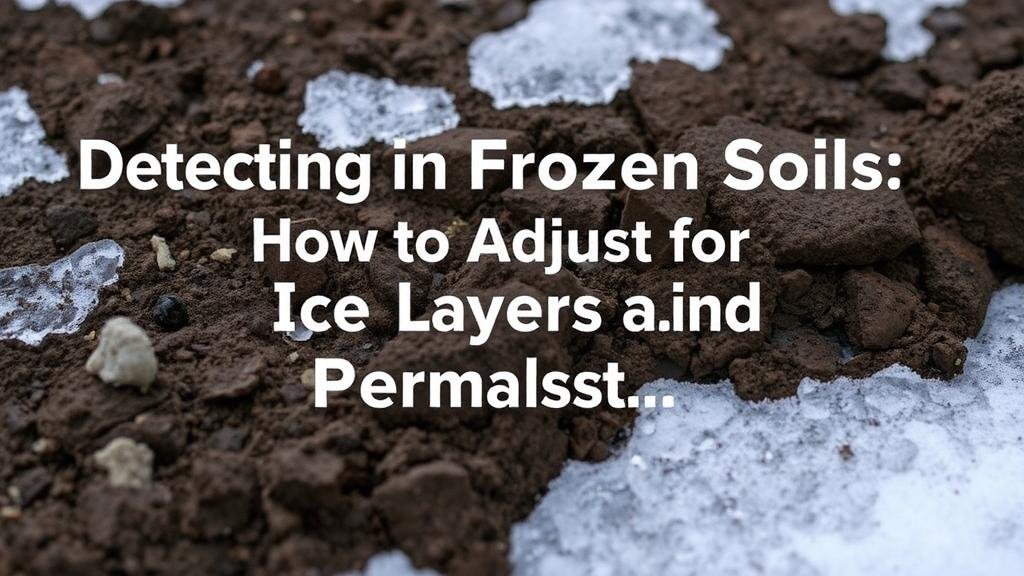Detecting in Frozen Soils: How to Adjust for Ice Layers and Permafrost
Detecting in Frozen Soils: How to Adjust for Ice Layers and Permafrost
Detecting changes in geological materials often presents unique challenges, particularly in cold regions where frozen soils, ice layers, and permafrost are prevalent. These environmental factors significantly influence various subsurface detection techniques, including geophysical surveys, soil sampling, and environmental monitoring. This article will discuss strategies to effectively detect and analyze frozen soils, and provide insights into adjusting methodologies when dealing with ice layers and permafrost.
The Importance of Understanding Frozen Soils
Frozen soils are more than just a seasonal phenomenon; they affect engineering projects, infrastructure stability, and ecological systems. Permafrost, defined as ground that remains at or below 0 degrees Celsius for at least two consecutive years, is a critical concept in regions like the Arctic tundra and subarctic environments. In these regions, the monitoring of frozen soils is essential for:
- Infrastructure planning and development, such as roads, pipelines, and buildings.
- Environmental assessments related to climate change.
- Geotechnical evaluations for civil engineering projects.
Statistics indicate that approximately 24% of the Northern Hemisphere is underlain by permafrost, affecting millions of square kilometers and influencing global climate dynamics. Detecting and assessing these areas requires specialized techniques tailored to the unique characteristics of frozen soil environments.
Challenges Posed by Ice Layers and Permafrost
Frozen soils present several challenges for detection methods:
- Soil conductivity variations: Ice has a higher resistivity compared to water-saturated soils, impacting electromagnetic surveys.
- Physical disturbances: The presence of ice lenses can lead to uneven ground surfaces and hinder sampling processes.
- In situ measurement difficulties: Conventional techniques may not provide accurate data in frozen states, necessitating adjustments to standard protocols.
Understanding these challenges can help in selecting appropriate detection methodologies and making necessary adjustments in techniques.
Techniques for Detecting Frozen Soils
Several geophysical and remote sensing techniques are effective in analyzing frozen soils. Below are some of them, alongside adjustments to accommodate the presence of ice layers and permafrost:
1. Ground Penetrating Radar (GPR)
GPR is a non-invasive method that transmits radar pulses into the ground. When detecting permafrost and ice layers, key adjustments include:
- Choosing the appropriate frequency: Higher frequencies can provide better resolution for surface features but may not penetrate deep enough in frozen conditions.
- Calibration for dielectric properties: Understanding how moisture and ice affect dielectric constants will enhance data accuracy.
In a case study in northern Alaska, GPR was effectively used to delineate permafrost boundaries while adjusting the frequency based on site-specific conditions, demonstrating its adaptability to frozen soils.
2. Electromagnetic (EM) Surveys
EM surveys measure the conductivity of soils, which varies with temperature and moisture content. Adjustments for ice layers include:
- Frequency selection: Using lower frequencies can penetrate deeper and provide insights into sub-ice structures.
- Modeling the ice-water transition: Incorporating temperature profiles into analysis can yield more precise conductivity models.
A practical application occurred in Canada’s Mackenzie Valley, where EM surveys effectively monitored the transitions of permafrost layers throughout seasonal changes.
3. Soil Sampling Techniques
Sampling methods must accommodate the different states of frozen soils. Effective strategies include:
- Utilizing heated sampling devices: These devices can maintain soil temperature during extraction, preserving its state for accurate analysis.
- Useing “frozen core†sampling techniques: This method minimizes disturbance to permafrost, ensuring sample integrity.
For example, a government study in Barrow, Alaska, successfully utilized frozen core techniques to characterize soil profiles in permafrost regions, providing critical data for climate and infrastructure assessments.
Future Directions in Frozen Soils Detection
The continual impact of climate change necessitates advancements in detection methodologies for frozen soils. Emerging technologies such as drone-based remote sensing and advanced modeling software are expected to enhance our capability to monitor and analyze these challenging terrains. Innovations in machine learning algorithms also hold the potential to improve data interpretation across diverse frigid environments.
Conclusion and Actionable Takeaways
Understanding how to adjust detection techniques for ice layers and permafrost is crucial for effective subsurface analysis in frozen soils. methodologies discussed–GPR, EM surveys, and soil sampling–are just a few examples of how sectors can adapt to the complexities presented by frozen conditions. Moving forward, leveraging technology and refining techniques based on empirical data will allow researchers and engineers to mitigate challenges associated with frozen soils effectively.
For professionals engaged in projects in frozen regions, it is essential to:
- Stay informed about the latest technologies and methodological advancements in frozen soils detection.
- Foster collaboration across disciplines to enhance data integration and interpretation.
- Engage in continuous education regarding the ecological implications of permafrost monitoring efforts.
By addressing these factors, professionals can ensure more reliable outcomes when working within frozen soil environments.



